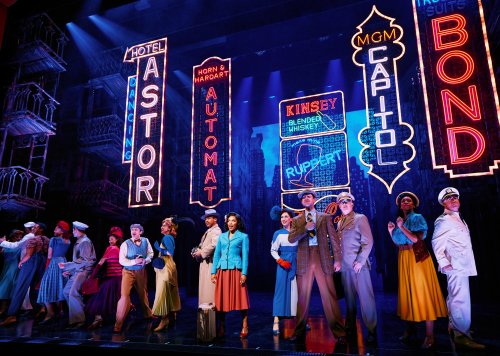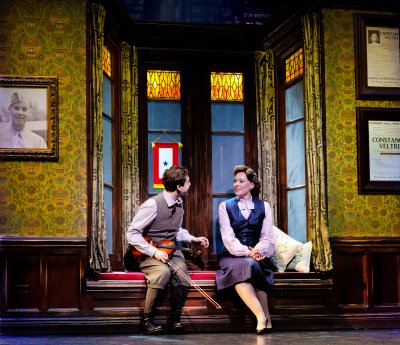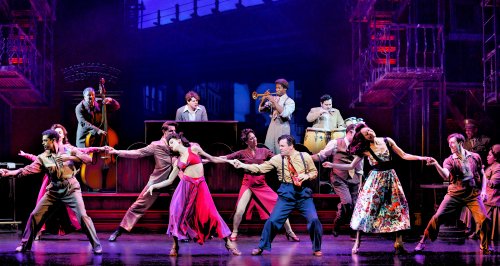New York, New York
Stage version of the Minnelli/De Niro film waters down the plot and adds multiple characters, plus trunks songs by John Kander and Fred Ebb and new songs by Kander and Lin-Manuela Miranda.

Anna Uzele (center) and cast in a scene from the new musical “New York, New York” at the St. James Theatre (Photo credit: Emilio Madrid)
[avatar user=”Victor Gluck” size=”96″ align=”left”] Victor Gluck, Editor-in-Chief[/avatar]
Martin Scorsese’s 1977 film New York, New York would seem a strange choice for a Broadway musical. An extremely long film, it was unsuccessful when first released. Composer John Kander and lyricist Fred Ebb’s original score only added four songs. While Liza Minnelli and Robert De Niro were at the top of their game with one Academy Award each by then, there was very little chemistry between them and De Niro’s Jimmy Doyle was abusive and objectionable as a saxophone player while Minnelli’s Francine Evans as a night club singer stood by until she had had enough. De Niro had no songs to sing, and Minnelli sang the bulk of the musical numbers.
The movie did have the iconic title song which became the unofficial anthem of New York City. The stage show has a new story by David Thompson, co-written by Sharon Washington, inspired by the original screenplay by Earl M. Rauch. Since Ebb passed away in 2004, Lin-Manuel Miranda was brought in to write original lyrics to new songs by Kander and polish up trunk songs by Kander and Ebb. The new score now has seven songs by Kander and Miranda, four new songs by Kander alone, four trunk songs from Kander and Ebb, two Kander and Ebb songs with additional lyrics by Miranda, and three songs from the original movie (three songs originally sung by Liza Minnelli), and one new Kander and Ebb song revised by Miranda. Ironically the two best songs are the most famous ones written for the film: “But the World Goes ‘Round” and “New York, New York” which is still as rousing as ever. Miranda’s new lyrics have acquired Ebb’s trick of oft repeated refrains and they fit themselves neatly into the Kander and Ebb score, while all of them are serviceable none memorable in themselves.

Clyde Alves, Colton Ryan and Anna Uzele in a scene from the new musical “New York, New York” at the St. James Theatre (Photo credit: Paul Kolnik)
The new story takes place in Manhattan from July 1946 – July 1947 and attempts to be a valentine to New York City with scenes taking place in many of Manhattan’s most iconic settings: Times Square, Grand Central Station, NBC Studios, East River and the Brooklyn Bridge, the Chrysler Building, Central Park. The plot now revolves around several people arriving in New York who hope to make it in the musical world. Francine Evans (Anna Uzele), still a singer, now arrives from Philadelphia to find a career in night club work. However, the new musical recasts her as Black so that most of her story is about her dealing with racism. She meets Irish jazz pianist Jimmy Doyle, alcoholic, pushy and aggressive, back in the city from serving in W.W. II when she auditions at a downtown polka club. Though she doesn’t get the job, she gets a boyfriend she can’t get rid of as he follows her wherever she goes even getting her a room in his boarding house run by Madame Veltri (Emily Skinner), a former singer, now a distinguished music teacher. Their up and down relationship parallels their story in the film but here Francine is careful not to get pregnant after they get married.
Along the way, they meet and follow other newcomers to NYC in search of a career in music and a better life: Black jazz trumpet player Jesse Webb (John Clay III), just out of the army and fleeing the racism in his home town, Cuban percussionist Mateo Diaz (Angel Sigala) who can’t get along with his abusive macho father, and the newly renamed “Alex Mann” (Oliver Prose), a Polish refugee who plays the violin and ends up taking lessons with Madame Veltri in order to get into Juilliard. We also meet suave but sleazy theatrical and musical producer Gordon Kendrick (Ben Davis) and a singing maid who ends up with a job at the Metropolitan Opera. The problem with the show is that it has too many characters to follow and Jimmy and Francine never become the heroes of their own story. Although set in 1946-47, the ambiance is much more recent and Francine is too much a feisty contemporary woman to be convincing in the post-war period.

Oliver Prose and Emily Skinner in a scene from the new musical “New York, New York” at the St. James Theatre (Photo credit: Paul Kolnik)
The idea of director/choreographer Susan Stroman’s production was most likely to create two new stars, as neither Colton Ryan (Girl from the North Country) nor Anna Uzele (Catherine Parr in SIX) are names likely to be recognized by the theatergoing public. Ryan’s Jimmy Doyle is played as a cut-rate James Cagney and he never exudes the kind of charisma that the plot requires. While not as abusive as Robert De Niro was in the film, he remains unpleasant, brash and loud with no redeeming characteristics other than that he plays a terrific jazzy piano. However, Uzele proves to be a big talent with a huge voice. Her Francine is endearing although we never learn enough about her. She should become a Broadway fixture in the coming years.
As Jesse Webb, John Clay III (Choir Boy, A Raisin in the Sun) plays a mean trumpet and makes a strong impression. Angel Sigala is amusing as the gay Mateo Diaz and plays numerous instruments. While Oliver Prose is a fine violinist, his Alex Mann isn’t given enough to do. As Jimmy’s friend Tommy Caggiano, who he grew up with and who always seems to be around at the right time to rescue him, veteran Clyde Alves (On the Town, The Music Man) is saddled with a role that is not clearly defined.

Both veterans, Emily Skinner and Ben Davis are wasted as the story concentrates on the younger characters. Skinner (The Cher Show, Prince of Broadway, Billy Elliott, Side Show) as the compassionate and understanding landlady is given only one song, Kander and Miranda’s “Better than Before,” not one of their best. As the debonair but treacherous producer, Ben Davis, one of the best theater baritones in the business, is given no songs at all. Stroman’s choreography is mainly used as transitions between scenes but she has created two dynamic production numbers: a totally gratuitous tap dance number by construction workers high up on the steel bars of a new skyscraper being built to Kander and Ebb’s trunk song, “Wine and Peaches,” and the torrid “San Juan Supper Club” number dance by Jimmy’s friend Tommy and the uncredited “Barfly” and ensemble which burns up the stage.
Aside from the many new songs, entries from the Kander and Ebb songbook include several from their lesser known scores: Flora the Red Menace, The Rink, Funny Lady, and Live from the Music Hall, mainly first presented by Liza Minnelli. “Happy Endings” used in the film as a Hollywood film production number but cut from the original release print, now becomes the finale of a Broadway show in which Francine makes her Broadway debut in the chorus and as a maid with one line of dialogue.

Richard Gatta, Ben Davis, Anna Uzele, Wendi Bergamini, Giovanni Bonaventura and Kristine Covillo in a scene from the new musical “New York, New York” at the St. James Theatre (Photo credit: Paul Kolnik)
The lavish and distracting production at times almost overpowers the show. Beowulf Boritt’s many colorful sets with projection design by Christopher Ash puts Manhattan on the stage. Aside from scenes like the old NBC radio studio and neon signs that say Hotel Astor and Horn and Hardart Automat, much of the time the scenes look more like today than the 1940’s. Donna Zakowska’s bland costumes in solid hues may have been created not to upstage the huge splashy sets. The lighting by Ken Billington adds a great deal of atmosphere. The arrangements by Sam Davis and the sound design by Kai Harada are fine work.
New York, New York is a big, jazzy show in the style of golden age musicals we have not seen for a while. While it removes the abusive relationship between Jimmy and Francine from the film, in doing so it waters down the story to a rather old-fashioned “newcomers make good in the big city” tale we have seen before. The theme of racism is handled rather simplistically, borrowing parts of the Lena Horne and Dorothy Dandridge stories. Characters seem to come and go and are often gone for too long a time. The new collaborations by Kander and Miranda are fun to hear but they do not come up to the standard of the Kander and Ebb songs that we know. The show becomes a showcase for the much loved songs “But the World Goes ‘Round” and “New York, New York” which are given pride of place.
New York, New York (through July 30, 2023)
St. James Theatre, 246 W. 44th Street, in Manhattan
For tickets, visit http://www.newyorknewyorkbroadway.com
Running time: two hours and 45 minutes with one intermission






Leave a comment